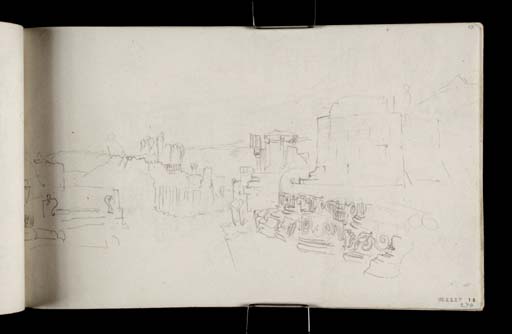Joseph Mallord William Turner View of the Via dei Sepolcri, Pompeii, from the Porta Ercolano 1819
Image 1 of 2
Joseph Mallord William Turner,
View of the Via dei Sepolcri, Pompeii, from the Porta Ercolano
1819
Joseph Mallord William Turner 1775–1851
Folio 10 Recto:
View of the Via dei Sepolcri, Pompeii, from the Porta Ercolano 1819
D15755
Turner Bequest CLXXXV 10
Turner Bequest CLXXXV 10
Pencil on white wove paper, 113 x 189 mm
Inscribed by ?John Ruskin in blue ink ‘278’ bottom right and ‘10’ top right
Stamped in black ‘CLXXXV 10’ bottom right
Stamped in black ‘CLXXXV 10’ bottom right
Accepted by the nation as part of the Turner Bequest 1856
References
1909
A.J. Finberg, A Complete Inventory of the Drawings of the Turner Bequest, London 1909, vol.I, p.547, as ‘Do. [Ruins]’.
1984
Cecilia Powell, ‘Turner on Classic Ground: His Visits to Central and Southern Italy and Related Paintings and Drawings’, unpublished Ph.D thesis, Courtauld Institute of Art, University of London 1984, pp.186 note 74, 491 note 32.
1987
Cecilia Powell, Turner in the South: Rome, Naples, Florence, New Haven and London 1987, pp.79 note 25, [82] note 60.
The subject of this sketch is a view of the Via dei Sepolcri (Street of the Tombs), Pompeii, looking west from the Porta Ercolano (Herculaneum Gate), the main entry point to the city from the Herculaneum and Rome road. During the early nineteenth century this was one of the most impressive and fully excavated sections of the Pompeii site, and consequently it was a popular subject for topographical artists. For example, this composition is virtually identical to that of the engraved plate after an 1817 drawing by James Pattinson Cockburn (1779–1847).1 The image was accompanied by a description of the scene:
Immediately on quitting the city, and passing the gates, this magnificent view offers itself. The pavement descends rapidly from the gate towards the plain, and the highway is lined on each side with tombs, richly decorated; thus at every step the admiration and sympathy of the traveller are excited, as he reads each succeeding inscription, commemorative of those, who enjoyed, so many centuries since, distinctions and influence in the state ... The first tomb that presents itself immediately without the gates is the large one to the right, at the base of which lie fragments of columns and entablatures, by some supposed to have formed part of the decoration of the City Gates, but more probably they are the fragments of some sepulchre or cenotaph. To the left, is seen a portion of the second exedra, with the three last letters, ETO, of the inscription. The covered seat of hemicycle, surmounted by a tiled roof, stands immediately beyond the tomb with the three pilasters and festoons, which latter are allusive to the practice of decorating the sepulchres with flowers at stated periods of the year.2
The same monuments described within this passage feature in Turner’s sketch. On the left-hand side is the exedra schola tomb of Mamia, a sepulchral monument in the form of a semicircular bench which is carved with a Latin dedication ending ‘ETO’. The inscription is missing from this drawing but was transcribed by the artist on another study, see folio 8 and 9 (D15751 and D15753). On the right-hand side meanwhile is the tomb of an unknown person, at the base of which are a number of architectural fragments. Beyond this is another unidentified tomb decorated with garland reliefs and the covered seat of a hemicycle. Both of these structures can be seen in folio 7 (D15750). For further studies of the Via dei Sepolcri see folios 5–6 verso and 9 verso (D15746–D15749 and D15754), and for a general discussion of Turner’s visit to Pompeii see the introduction to the sketchbook.
Nicola Moorby
September 2010
How to cite
Nicola Moorby, ‘View of the Via dei Sepolcri, Pompeii, from the Porta Ercolano 1819 by Joseph Mallord William Turner’, catalogue entry, September 2010, in David Blayney Brown (ed.), J.M.W. Turner: Sketchbooks, Drawings and Watercolours, Tate Research Publication, December 2012, https://www


